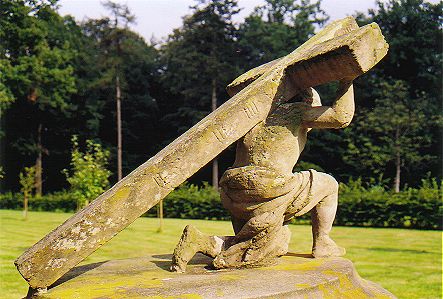
Pole-style dials
Clemenswerth Manor (Sögel, Germany)

Two conspicuous sundials are found in the convent garden of Clemenswerth Manor. The extraordinary cross dial is depicted above: a kneeling Christ carrying a cross. According to Zenkert, cross dials were popular in the 18th century because of their sacred nature. This is a copy, though, of the 1737 original that is in the museum now.
The top of the cross is pointing south, so that the edges of the beams are parallel to the earth's axis. These edges thus are pole-styles. Depending on the time of day, one or two edges cast a shadow on the adjacent side, where the time can be read. The edges on the top of the main beam cast their shadow on the side of the cross beam. Together they form a polar dial. The edges of the cross beam cast their shadow on the sides of the main beam. They thus form a vertical east and a vertical west dial.
When the date is not close to the equinoxes, the shadow of the edge tends to fall beyond the dial faces, as is the case above. Therefore, the beams are often made somewhat thicker than seen here.
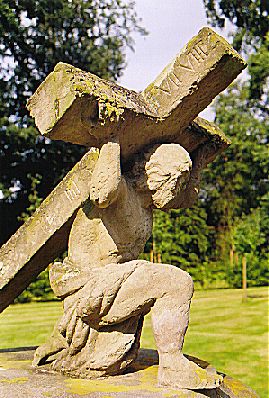 |
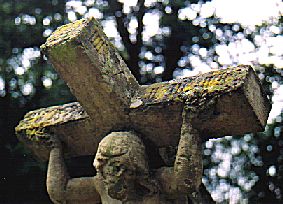 |
| The dial runs from 4 to 10 o'clock on the east side, from 8 to 4 (16) o'clock on the south side and from 2 (14) to 8 (20) o'clock on the west side. |
Code: DGC 750
Location: 52.8° N, 7.6° E
Equatorial dial
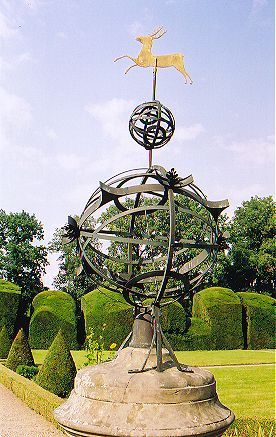 |
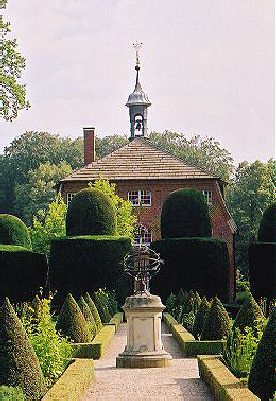 |
The double armillary sphere with the gilded deer on top is set on a base similar to the cross dial. The equator ring carries a number of protrusions, the function of which is unclear to me. These are not secondary scales, as I could find no hour marks. One of the rings is almost, but not exactly horizontal. Does this dial come from a more southern location? Maybe a present from one of Clemens' guests, or from his brother in Munich?
Clemenswerth Manor (website in German) was built between 1737 and 1747 for the Cologne Elector Clemens August von Wittelsbach (1700-1761). The architect was Johann Conrad Schlaun from Münster. It is one of the most charming rococo castles, harmoniously set in the park with its star-like layout. Clemens August loved to come here to hunt deer in the vast Hümmling forest.
It is always a special experience to stroll through such a splendid park with its high-reaching oaks and beeches, realizing that neither the designer nor the principal ever saw it in this monumental state, and that they knew it. What they didn't know, however, is that the French Revolution would rage, so that their creation now can be enjoyed by the common people. And that certainly was not what they had in mind...
The central building (3) is the manor proper. The pavilions, arranged strictly symmetrically around it, housed the noble guests. A sensible arrangement: the guests could do their own things without annoying their host or each other.
The manor's Chapel is located in the Capuchin convent (9), which is still in operation today. Its patron is St. Hubert; indeed, the patron saint of hunting.
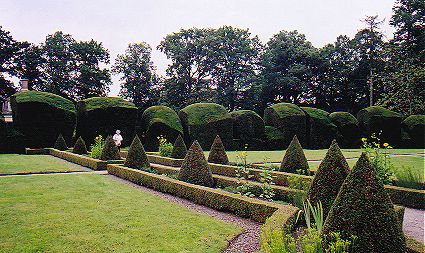
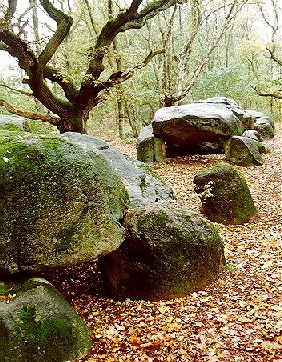 The convent garden consists of two parts. The inner, more formal part is completely lined by oddly trimmed yew trees. They are said to mimic the megalithic tombs found in the region (cf. the site by Hans Meijer).
The convent garden consists of two parts. The inner, more formal part is completely lined by oddly trimmed yew trees. They are said to mimic the megalithic tombs found in the region (cf. the site by Hans Meijer).
The armillary sphere is located on the intersection of the two central pathways.
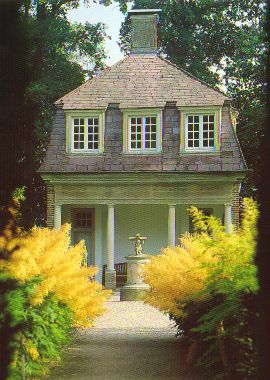
The key to the convent garden has to be obtained at the cash desk (deposit!), so as to admit only paying visitors. You have to lock the gate again, so that unauthorized persons cannot sneak in behind you, and you are allowed only 15 minutes. One can imagine that this scheme sometimes elicits disputes between visitors that do not fit the sacred atmosphere of the garden...
Clemenswerth is located just outside Sögel and houses the regional Emslandmuseum. Sögel is found in northwest Germany, some 30 km (20 miles) from the Dutch border. More information about the Emsland region can be found here (in German).
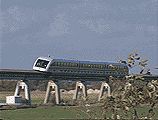 A more prosaic attraction is the Transrapid test circuit near Lathen (10 km west), the magnetic hovertrain that one day may bring us from Groningen to Amsterdam within an hour, or equally swiftly to Bremen, Hamburg and Berlin...
A more prosaic attraction is the Transrapid test circuit near Lathen (10 km west), the magnetic hovertrain that one day may bring us from Groningen to Amsterdam within an hour, or equally swiftly to Bremen, Hamburg and Berlin...